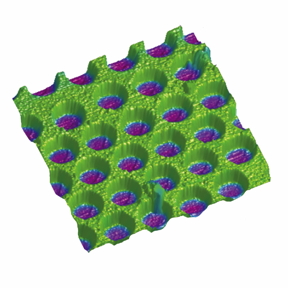Home > Press > Bruker Introduces Complete Commercial AFM-Based SECM Solution: PeakForce SECM Mode Enables Previously Unobtainable Electrochemical Information
 |
Abstract:
Bruker’s Nano Surfaces Division today announced the release of scanning electrochemical microscopy (SECM) capability for its Dimension Icon® atomic force microscope (AFM) platform. Utilizing a proprietary probe design, Bruker’s new PeakForce SECM™ mode controls nanoelectrode tip position and tip-sample interaction with unprecedented precision to provide simultaneous capture of topographical, electrochemical, electrical, and mechanical maps. This capability provides access to previously unobtainable nanoscale observation of redox reactions and their kinetics. Now researchers are able to address vital evolution of materials for energy, environment, and biochemical sensors.
Bruker Introduces Complete Commercial AFM-Based SECM Solution: PeakForce SECM Mode Enables Previously Unobtainable Electrochemical Information
Santa Barbara, CA | Posted on September 20th, 2016“Our customers have been consistently imaging at very high resolution with the new nanoelectrodes on the Dimension Icon AFM,” said Teddy Huang, Ph.D., Senior Applications Scientist at Bruker Nano Surfaces Division. “For the first time they are able to capture electrochemistry correlated with nanomechanical information to understand the complex relationship between size, geometry, modulus, adhesion, and activity of nanostructured materials.”
“PeakForce SECM radically redefines what is possible in the nanoscale visualization of electrical and chemical processes in liquid,” added Marco Tortonese, Ph.D., Vice President and General Manager of Bruker’s AFM Instrumentation Business. “This breakthrough is the result of the continuing evolution of PeakForce Tapping® technology combined with our in-house design and manufacture of reliable commercial probes.”
About PeakForce SECM
PeakForce SECM takes full advantage of Bruker’s exclusive PeakForce Tapping to deliver a new approach to SECM that extends its capability to nanoscale electrochemistry, electrical and mechanical mapping of a wide variety of samples, from soft biological systems to polymers. Bruker’s PeakForce SECM probes are batch-fabricated using proprietary methods to consistently produce a high-quality nanoelectrode. An optimized conductive path and special coating techniques eliminate pinholes, resulting in negligible leakage and capacitive currents. PeakForce SECM improves resolving power over traditional approaches by orders of magnitude, and opens the door to electrochemical measurements on individual nanoparticles, nanophases, and nanopores.
####
About Bruker Corporation
For more than 50 years, Bruker has enabled scientists to make breakthrough discoveries and develop new applications that improve the quality of human life. Bruker’s high-performance, scientific research instruments and high-value analytical solutions enable scientists to explore life and materials at molecular, cellular and microscopic levels.
In close cooperation with our customers, Bruker is enabling innovation, productivity and customer success in life science molecular research, in applied and pharma applications, in microscopy, nano-analysis and industrial applications, as well as in cell biology, preclinical imaging, clinical research, microbiology and molecular diagnostics.
For more information, please click here
Contacts:
Robert Ligeti, Marketing Communications, Manager
Bruker Nano Surfaces Division
T: +1 (408) 376-4065 x4065
Copyright © Bruker Corporation
If you have a comment, please Contact us.Issuers of news releases, not 7th Wave, Inc. or Nanotechnology Now, are solely responsible for the accuracy of the content.
| Related News Press |
News and information
![]() Researchers develop molecular qubits that communicate at telecom frequencies October 3rd, 2025
Researchers develop molecular qubits that communicate at telecom frequencies October 3rd, 2025
![]() Next-generation quantum communication October 3rd, 2025
Next-generation quantum communication October 3rd, 2025
![]() "Nanoreactor" cage uses visible light for catalytic and ultra-selective cross-cycloadditions October 3rd, 2025
"Nanoreactor" cage uses visible light for catalytic and ultra-selective cross-cycloadditions October 3rd, 2025
Imaging
![]() ICFO researchers overcome long-standing bottleneck in single photon detection with twisted 2D materials August 8th, 2025
ICFO researchers overcome long-standing bottleneck in single photon detection with twisted 2D materials August 8th, 2025
![]() Simple algorithm paired with standard imaging tool could predict failure in lithium metal batteries August 8th, 2025
Simple algorithm paired with standard imaging tool could predict failure in lithium metal batteries August 8th, 2025
![]() First real-time observation of two-dimensional melting process: Researchers at Mainz University unveil new insights into magnetic vortex structures August 8th, 2025
First real-time observation of two-dimensional melting process: Researchers at Mainz University unveil new insights into magnetic vortex structures August 8th, 2025
![]() New imaging approach transforms study of bacterial biofilms August 8th, 2025
New imaging approach transforms study of bacterial biofilms August 8th, 2025
Announcements
![]() Rice membrane extracts lithium from brines with greater speed, less waste October 3rd, 2025
Rice membrane extracts lithium from brines with greater speed, less waste October 3rd, 2025
![]() Researchers develop molecular qubits that communicate at telecom frequencies October 3rd, 2025
Researchers develop molecular qubits that communicate at telecom frequencies October 3rd, 2025
![]() Next-generation quantum communication October 3rd, 2025
Next-generation quantum communication October 3rd, 2025
![]() "Nanoreactor" cage uses visible light for catalytic and ultra-selective cross-cycloadditions October 3rd, 2025
"Nanoreactor" cage uses visible light for catalytic and ultra-selective cross-cycloadditions October 3rd, 2025
Tools
![]() Japan launches fully domestically produced quantum computer: Expo visitors to experience quantum computing firsthand August 8th, 2025
Japan launches fully domestically produced quantum computer: Expo visitors to experience quantum computing firsthand August 8th, 2025
![]() Rice researchers harness gravity to create low-cost device for rapid cell analysis February 28th, 2025
Rice researchers harness gravity to create low-cost device for rapid cell analysis February 28th, 2025
|
|
||
|
|
||
| The latest news from around the world, FREE | ||
|
|
||
|
|
||
| Premium Products | ||
|
|
||
|
Only the news you want to read!
Learn More |
||
|
|
||
|
Full-service, expert consulting
Learn More |
||
|
|
||








